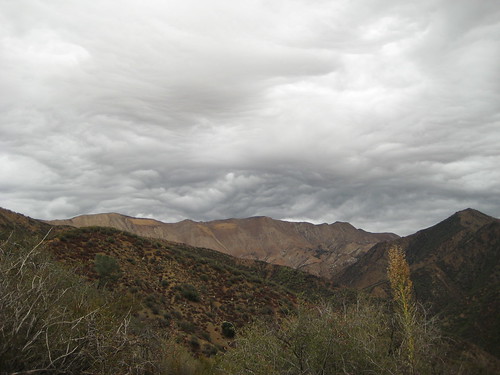In the last few weeks, Australia has been hit with downright apocalyptic floods. Entire cities have been flooded, normally-dry creeks have risen to shocking levels, and tragic loss of life has occurred.
To most of the people who read this blog, Australia is a far away place. The floods are shocking and upsetting, but they are occurring in a place that is very different than the one we are familiar with.
The uncomfortable truth, however, is that such storms CAN happen in the United States as well. In fact, that similar floods have happened in the not-that-distant past - as close to home as California. In 1862, a series of intense storms turned the entire Central Valley into a lake, and entire cities were wiped off the map. Geologic evidence indicates that EVEN STRONGER storms have happened since the last ice age. And, a warming climate could make future storms of this sort more frequent than they have been in the past.

Above: this remote ridge in California's Los Padres National Forest is called Hurricane Deck for a reason. The Transverse Range of southern California does a very good job of blocking and amplifying storms that approach from the south, and in extreme conditions, areas of these mountains have been known to get over 20 inches of rain in a DAY.
Note: I apparently misspelled this as 'ARcSTORM which is, I guess, some sort of GIS program. The correct spelling is ARkSTORM. A lot of people have been finding this blog page because they made the same spelling mistake as I did.
Please see this USGS site for info on a project to raise awareness and increase preparation for such a storm system. Click below for more info and thoughts on the potential for major flooding in California.
The watersheds of California were in better shape in the 1860s than now, though uncontrolled free-range cattle and some invasive species were already causing some damage at that time. Healthy watersheds wouldn't stop a storm of this magnitude from devastating California. It's safe to say though that non-functional watersheds would make the disaster even worse.
***UPDATE: (01-18-2010) *** I've noticed that a lot of people are coming to this blog via Google and are interested in/concerned about this so-called ARkStorm. Some people are saying that it's just another media hype-fest, while others seem rather upset and concerned. The bottom line, unfortunately, is that there is a very definite historical precedent for massive floods in California, and sediment records and other geological evidence points to the fact that indeed, floods have occurred in California that are far beyond anything we have seen in the past century (and let's face it, this century has had some nasty floods). The good news is that these floods are quite rare, and hopefully will not recur within any of our lifetimes. The bad news is they almost certainly WILL recur at some point, and nothing, not our dams and levees, not our sediment basins, not even abundant beavers and large-scale watershed restoration, would stop it from being a major disaster. Our best bet right now is to research the historic and prehistoric flooding to the extent possible, so that we understand more fully what could happen. Ultimately, it may be much like a hurricane in that we can see it coming, but we can't do anything to stop it, and just need to get out of the way or hole up in safe places until it passes.
There is a very good description of the 1862 floods here. I was interested in the mention of snow falling at low elevations. Apparently this storm pattern included tropical moisture but also very cold air.
Here is the wikipedia article about the floods. Note that this was not an El Nino event.
Here is a historic record from the time period. There is also a lot of institutionalized racism/ethnic slurs/etc in this record, which are a bit upsetting, but also an illustration of how people viewed the world in those times.
The bottom line: Weather and climate are much more dynamic and extreme than we realize. Even setting aside human effects on climate, evidence from the past indicates that floods, droughts, hurricanes, and other weather that is harmful to humans, may have all been more common during past climate regimes. In Two Years Before the Mast, Richard Henry Dana described torrential storms and southeasterly gales beyond what we experience in the current day. Our relatively calm climate pattern of the last century or so may be coming to an end. Our best bet: Take care of our watersheds and ecosystems, learn as much as we can about past, present, and future climate, and try to avoid doing things that might cause the climate to change in ways that will harm us, hope that we live full, long lives without ever seeing the sort of floods that happened in 1862, but prepare as best we can just in case we aren't so lucky.

No comments:
Post a Comment